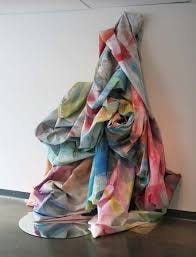
Sam Gilliam’s career is a testament to artistic innovation and boundary-pushing in abstract art. Known predominantly for his signature draped canvases, Gilliam redefined what a painting could be by transforming the traditional, rigid canvas into a flexible, sculptural medium.
Sam Gilliam was born on November 30, 1933, in Tupelo, Mississippi, and later raised in Louisville, Kentucky. Growing up during a period of significant social and cultural change, Gilliam was exposed to both Southern traditions and the burgeoning modern art movements. He earned his bachelor’s degree at the University of Louisville and went on to complete his graduate studies at the University of Cincinnati, where he absorbed the influences of abstract expressionism and color field painting. According to The HistoryMakers, Gilliam’s early exposure to a variety of artistic practices laid the groundwork for his later experimentation with form and structure (The HistoryMakers). These academic experiences, combined with his personal determination, equipped him with the tools to challenge the traditional confines of painting.
By the early 1960s, Gilliam had relocated to Washington, D.C., where he became associated with the Washington Color School; a group known for their emphasis on color field painting. However, Gilliam was never content to remain within the boundaries set by any movement. In the late 1960s and early 1970s, he began to experiment with the physical nature of the canvas. Rather than adhering to the conventional, rectangular frame, Gilliam started to drape, fold, and suspend his canvases. This radical approach turned the canvas from a flat surface into a three-dimensional object, effectively merging painting with sculpture. As Tate notes, Gilliam’s draped canvases “challenge the spatial limits of painting” and invite viewers to reconsider the relationship between form, color, and space (Tate). His work during this period reflects a deep engagement with both gestural abstraction and the physical properties of his materials; a duality that has become central to his legacy.


Gilliam’s innovations gained widespread recognition through exhibitions at prestigious institutions. Notable works such as Double Merge (1968) and Carousel State (1968) exemplify his signature technique, where the canvas is transformed into a flowing, dynamic form that interacts with light and space. His work has been featured in major museums such as the Museum of Modern Art (MoMA) in New York, the Smithsonian American Art Museum, and Tate Modern in London. For instance, MoMA’s online collection (MoMA) and the Smithsonian’s archives (Smithsonian American Art Museum) document his contributions and contextualize his work within the broader narrative of American abstract art. Additionally, The New York Times obituary for Gilliam provides a critical overview of his career and underscores the enduring influence of his innovations (The New York Times).
Gilliam’s exhibitions have not only celebrated his technical achievements but have also spurred discussions about the evolution of art in the digital age. An Artsy article from 2016 highlights how, even at 85, Gilliam continued to push creative boundaries, reaffirming his status as a pioneering abstract artist (Artsy). These exhibitions and critical analyses confirm that his work remains both influential and relevant to contemporary discussions about art and innovation.

Sam Gilliam’s contributions to modern art have been profound. His draped canvas works shattered the conventional limitations of the medium, inspiring a generation of artists to explore the relationship between painting and sculpture. As noted by the National Gallery of Art, Gilliam’s work has redefined abstract painting, encouraging artists to consider the physicality of the canvas as integral to the work’s meaning (National Gallery of Art).
Moreover, his influence extends beyond the realm of painting; it has contributed to a broader understanding of spatial dynamics in contemporary art. Scholars such as Elizabeth Johnson, writing for Artforum, have noted that Gilliam’s “manipulation of the canvas’ form invites an experiential engagement that transcends traditional viewing” (Johnson 45–50). This innovative spirit continues to resonate in today’s art scene, where boundaries between different media are increasingly blurred.

Gilliam’s legacy is also institutionalized through ongoing exhibitions and retrospectives. The Smithsonian American Art Museum and other major institutions ensure that his work is studied and appreciated by future generations, securing his place in the pantheon of American art pioneers. His relentless pursuit of innovation, even into his later years, serves as a beacon for artists who challenge norms and dare to reimagine the potential of their medium.
Sam Gilliam’s artistic journey, from his early life in mid‑century America to his groundbreaking draped canvases, epitomizes the transformative power of innovation in art. By breaking away from traditional formats, he not only expanded the possibilities of abstract painting but also redefined the viewer’s experience of art. His work continues to inspire and provoke discussion among artists, scholars, and enthusiasts alike, cementing his legacy as one of the foremost pioneers of modern art. As we celebrate his contributions, we recognize that Gilliam’s daring experiments have forever altered the trajectory of abstract art, reminding us that creativity knows no bounds.
References:
Artsy. At 85, Sam Gilliam Is Still Making Innovative Paintings. Artsy, 2016, https://www.artsy.net/article/artsy-editorial-85-abstract-pioneer-sam-gilliam-making-innovative-paintings. Accessed 6 Jan. 2025.
Johnson, Elizabeth. Draped in Color: The Revolutionary Works of Sam Gilliam. Artforum, vol. 54, no. 3, 2016, pp. 45–50.
Sam Gilliam. Museum of Modern Art, https://www.moma.org/artists/1768. Accessed 6 Jan. 2025.
Sam Gilliam. Smithsonian American Art Museum, https://americanart.si.edu/artist/sam-gilliam-1811. Accessed 6 Jan. 2025.
Sam Gilliam. Tate, https://www.tate.org.uk/art/artists/sam-gilliam-13627. Accessed 6 Jan. 2025.
The HistoryMakers: Sam Gilliam. The HistoryMakers, https://www.thehistorymakers.org/biography/sam-gilliam-41. Accessed 6 Jan. 2025.
Sam Gilliam, Painter Who Transformed the Canvas, Dies at 89. The New York Times, 3 Feb. 2022, https://www.nytimes.com/2022/02/03/arts/sam-gilliam-dead.html. Accessed 6 Jan. 2025.
Sam Gilliam. National Gallery of Art, https://www.nga.gov/collection/artist-info. Accessed 6 Jan. 2025.




I am in love. Other than that, if I wrote what I am thinking, we will get censored. Basically if I went to one of these exhibitions it would be very ‘Harry Met Sally scene in the diner’ for me.